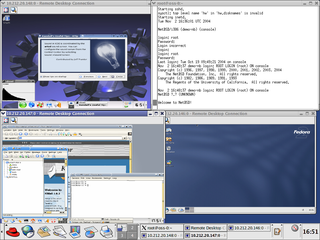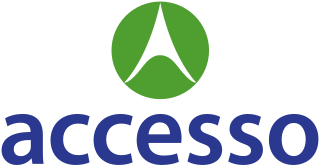Trusted Computing (TC) is a technology developed and promoted by the Trusted Computing Group. The term is taken from the field of trusted systems and has a specialized meaning that is distinct from the field of confidential computing. With Trusted Computing, the computer will consistently behave in expected ways, and those behaviors will be enforced by computer hardware and software. Enforcing this behavior is achieved by loading the hardware with a unique encryption key that is inaccessible to the rest of the system and the owner.
Social software, also known as social apps or social platform includes communications and interactive tools that are often based on the Internet. Communication tools typically handle capturing, storing and presenting communication, usually written but increasingly including audio and video as well. Interactive tools handle mediated interactions between a pair or group of users. They focus on establishing and maintaining a connection among users, facilitating the mechanics of conversation and talk. Social software generally refers to software that makes collaborative behaviour, the organisation and moulding of communities, self-expression, social interaction and feedback possible for individuals. Another element of the existing definition of social software is that it allows for the structured mediation of opinion between people, in a centralized or self-regulating manner. The most improved area for social software is that Web 2.0 applications can all promote co-operation between people and the creation of online communities more than ever before. The opportunities offered by social software are instant connections and opportunities to learn. An additional defining feature of social software is that apart from interaction and collaboration, it aggregates the collective behaviour of its users, allowing not only crowds to learn from an individual but individuals to learn from the crowds as well. Hence, the interactions enabled by social software can be one-to-one, one-to-many, or many-to-many.
Generative music is a term popularized by Brian Eno to describe music that is ever-different and changing, and that is created by a system.

Xen is a free and open-source type-1 hypervisor, providing services that allow multiple computer operating systems to execute on the same computer hardware concurrently. It was originally developed by the University of Cambridge Computer Laboratory and is now being developed by the Linux Foundation with support from Intel, Citrix, Arm Ltd, Huawei, AWS, Alibaba Cloud, AMD, Bitdefender and EPAM Systems.

Computervision, Inc. (CV) was an early pioneer in Computer Aided Design and Manufacturing (CAD/CAM). Computervision was founded in 1969 by Marty Allen and Philippe Villers, and headquartered in Bedford, Massachusetts, United States. Its early products were built on a Data General Nova platform. Starting around 1975, Computervision built its own "CGP" Nova-compatible 16-bit computers with added instructions optimized for graphics applications and using its own operating system known as Computervision Graphic Operating System (CGOS). In the 1980s, Computervision rewrote their code to operate on Unix-based platforms.
Wind River Systems, Inc., also known as Wind River, is an Alameda, California–based company, subsidiary of Aptiv PLC. The company develops embedded system and cloud software consisting of real-time operating systems software, industry-specific software, simulation technology, development tools and middleware.
Nitix was a retail Linux distribution, produced in Canada. The software is developed by Net Integration Technologies, Inc., which has been acquired by IBM as of January 2008 and currently operates as IBM Lotus Foundations.
Synapse Audio Software is a software company located in Germany. Previously known as Sonic Syndicate and headed by Richard Hoffmann, they develop music production software for the Mac OS and Microsoft Windows platforms. They started developing software in November 1998 as Sonic Syndicate and changed their name to Synapse Audio with the release of Orion Platinum in 2002.

Zeus Technology, Ltd. was a software company founded in 1995 and based in Cambridge, England, known for its web server. In July 2011, Zeus Technology was acquired by Riverbed Technology. In March 2015, Riverbed Technology sold the SteelApp business unit to Brocade Communications Systems. In June 2017, Brocade Communications Systems sold the vADC business unit to Pulse Secure. In December 2020 Pulse Secure, including the vADC business unit, was acquired by Ivanti.
Koan is a generative music engine created by SSEYO, a company founded by Pete Cole and Tim Cole. The Koan technology is now owned by Intermorphic Limited, co-founded by the Cole brothers in 2007.
Kaltura, Inc. is a New York-based software company founded in 2006. It operates in several major markets: webinars and virtual events, enterprise video content management and online video platform (OVP), educational technology, and Cloud TV software, and offers products such as video portal, LMS and CMS extension, virtual event and webinar platform, and TV streaming app.

In computing, virtualization (v12n) is a series of technologies that allows dividing of physical computing resources into a series of virtual machines, operating systems, processes or containers.

AppScale is a software company that offers cloud infrastructure software and services to enterprises, government agencies, contractors, and third-party service providers. The company commercially supports one software product, AppScale ATS, a managed hybrid cloud infrastructure software platform that emulates the core AWS APIs. In 2019, the company ended commercial support for its open-source serverless computing platform AppScale GTS, but AppScale GTS source code remains freely available to the open-source community.
The following outline is provided as an overview of and topical guide to software:
The Techila Distributed Computing Engine is a commercial grid computing software product. Techila Distributed Computing Engine is developed and licensed by Techila Technologies Ltd, a privately held company headquartered in Tampere, Finland. The product is also available as an on-demand solution in Google Cloud Launcher, the online marketplace created and operated by Google.

Accesso Technology Group PLC is a publicly listed technology company based in Berkshire, England. Accesso has 9 offices across the world, and serves 1000 venues globally, providing ticketing, point of sale, virtual queuing, distribution and guest experience management solutions.
Network functions virtualization (NFV) is a network architecture concept that leverages IT virtualization technologies to virtualize entire classes of network node functions into building blocks that may connect, or chain together, to create and deliver communication services.
Mycroft was a free and open-source software virtual assistant that uses a natural language user interface. Its code was formerly copyleft, but is now under a permissive license. It was named after a fictional computer from the 1966 science fiction novel The Moon Is a Harsh Mistress.
Timothy Didymus is a British artist and musician based in Brighton. He is considered a pioneer in the field of generative music. Didymus has collaborated with artists such as Brian Eno, Cornelia Sollfrank, Emilia Telese and presented at institutions and festivals such as ZKM, Ars Electronica, International Symposium on Electronic Art (ISEA), Werkleitz Biennale of Multimedia Arts, Liverpool Biennial, De La Warr Pavilion, Fort Process.






